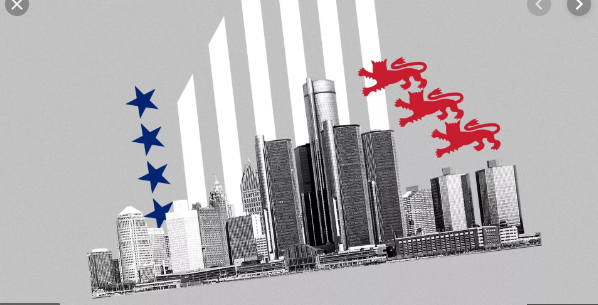For decades, the world has pointed to Detroit as a symbol of the entire Rust Belt and the decay of American manufacturing. But the city is attempting to change that narrative — and succeeding.
Why it matters: Detroit may be the starkest example, but its story is mirrored in dozens of U.S. cities — Columbus, Pittsburgh and Toledo among them — that have shared its challenges and are embarking on comebacks of their own.
What’s happening: The mayor’s office, nonprofits and Detroit’s Fortune 500 companies are coming together to turn the city around. Detroit is changing so fast that its transformation over the last decade was visible from outer space.
In the last 10 years, Detroit has turned many of its longtime problems around — and attracted jobs in industries that will shape the future.
- The site that used to be home to Hudson’s — once the country’s biggest department store and the crown jewel of Detroit’s downtown — has been revamped. It’s turning into a new, futuristic skyscraper with shops, office space and a hotel. Dan Gilbert, the billionaire co-founder of Quicken Loans, is behind that project as well as much of the development around the rest of downtown.
- While automakers are — and likely always will be — the major employers in the region, a slew of new industries have come to town, including fintech, cybersecurity, health care IT and retail, says Ned Staebler, vice president of economic development at Wayne State University, in the heart of Detroit.
- On top of that, autonomous vehicle makers are targeting Detroit due to its roots in the car business. Waymo is putting a factory in Detroit, and Ford is turning an abandoned train station in the city into its AV center.
- And the city has pulled in some Big Tech. Microsoft has an office downtown, and LinkedIn just announced plans to build a big outpost in Detroit.
But, but, but: Many of the economic and demographic trends that are shaping the future of American cities are working against Detroit and cities like it.
- Robotics and AI are taking over — or deeply altering — jobs in advanced manufacturing, which remains a key pillar of Detroit’s economy.
- The city keeps getting beat out by superstar metros in the war for talent and jobs. Detroit worked hard to get Amazon to build its second headquarters in town, but lost to D.C. “A lot of cities wanted it, but we wanted it the most,” a person familiar with Detroit’s bid told Axios.
And while Detroit has made big strides in its reinvention, it’s still losing people — despite efforts to bring in new people and get college graduates to stay. “The population number is the number by which we either win or we lose,” Mayor Mike Duggan told the New York Times.
- In 1950, Detroit had 1.85 million people, making it the fourth-largest city in the country. Today, the population has dwindled to under 675,000, a 100-year-low, largely due to the decline of the once-kingly automakers.
For article, click below:
Source: Detroit turns around after decades of decline – Axios


